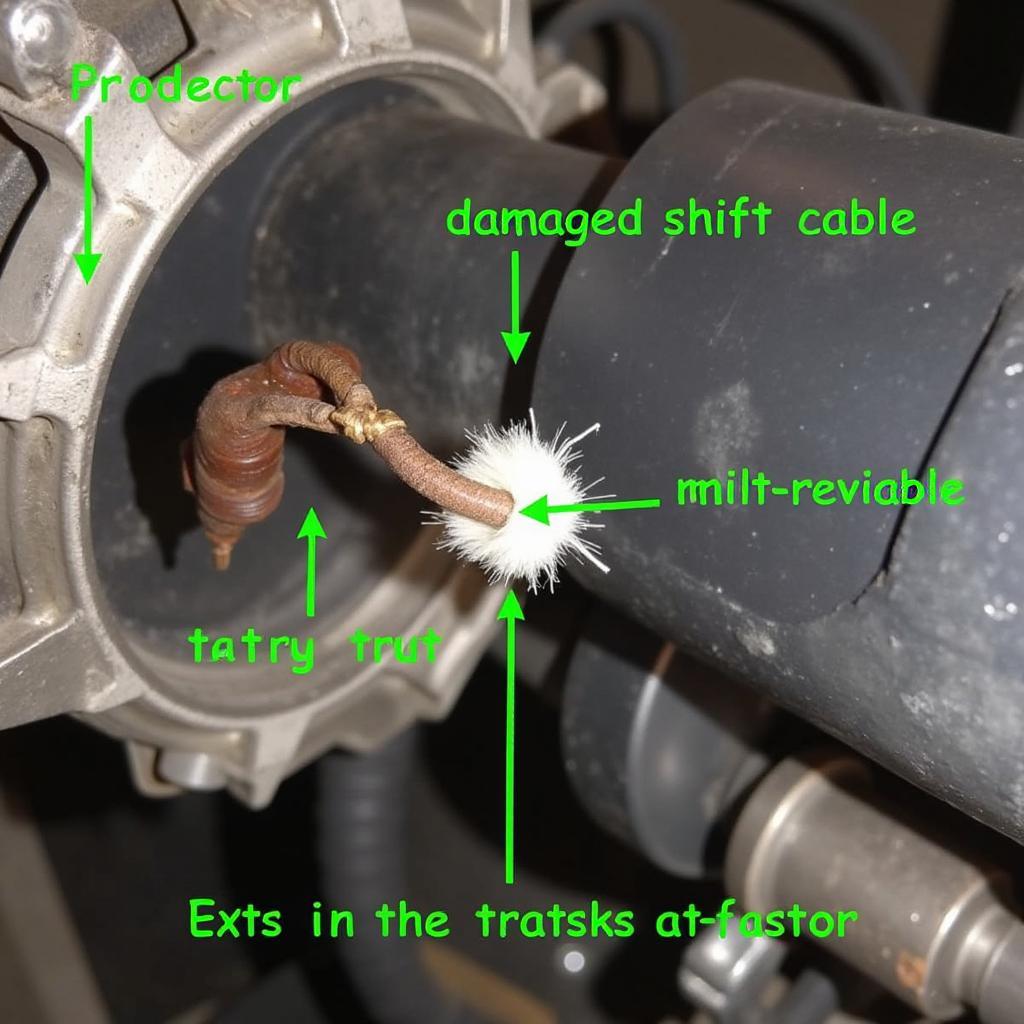If your car has problem with reverse, you’re not alone. This is a surprisingly common issue, and can range from a simple fix to a more complex transmission problem. This guide will help you diagnose the problem and understand the potential solutions, whether you’re a car owner, a mechanic, or an automotive technician.
Common Causes of Reverse Gear Problems
There are several reasons why your car might be having trouble with reverse. Understanding the potential culprits can help you narrow down the issue and potentially save you time and money on repairs.
- Low Transmission Fluid: This is perhaps the most common and easiest to fix. Low transmission fluid can cause a variety of problems, including difficulty shifting into reverse.
- Faulty Shift Cables or Linkage: Worn or damaged shift cables or linkage can prevent the transmission from fully engaging reverse gear. This can manifest as a grinding noise when shifting or the car not moving at all in reverse.
 Damaged shift cable connected to car transmission
Damaged shift cable connected to car transmission - Transmission Solenoids: These electronically controlled valves regulate the flow of transmission fluid. A malfunctioning solenoid can disrupt the hydraulic pressure needed for reverse gear engagement.
- Worn Clutch (Manual Transmissions): A worn clutch can make it difficult to engage any gear, including reverse. You might experience grinding or a slipping sensation.
- Internal Transmission Damage: This is the most serious and expensive potential problem. Internal damage to the gears, bands, or clutches within the transmission can prevent reverse from working altogether.
How to Diagnose Your Reverse Gear Issue
Diagnosing the problem yourself can sometimes be possible before taking your car to a mechanic. Here are some steps you can take:
- Check the Transmission Fluid: Locate the transmission dipstick (consult your owner’s manual) and check the fluid level and condition. Low or dirty fluid can indicate a problem.
- Listen for Unusual Noises: When attempting to shift into reverse, listen for grinding, clicking, or whining sounds. These can provide clues about the source of the problem.
- Check for Leaks: Inspect the area around the transmission for any signs of fluid leaks. A leak can lead to low fluid levels and transmission problems.
- Inspect the Shift Linkage: If you’re comfortable working under your car, you can visually inspect the shift linkage for damage or looseness.
What to Do If Your Car Won’t Go in Reverse
If you’ve tried the basic troubleshooting steps and your car still has problem with reverse, it’s time to seek professional help. A qualified mechanic can accurately diagnose the issue and recommend the necessary repairs.
- Contact a Reputable Mechanic: Choose a mechanic specializing in transmission repair.
- Describe the Symptoms Clearly: Be prepared to describe the problem in detail, including any noises or unusual behavior you’ve noticed.
“A thorough diagnosis is crucial for addressing reverse gear problems effectively. Don’t hesitate to ask your mechanic questions about the diagnosis and repair process,” advises John Miller, Certified Automotive Technician at Autotippro.
Preventing Future Reverse Gear Issues
Regular maintenance is key to preventing transmission problems.
- Regular Transmission Fluid Changes: Follow your car manufacturer’s recommended service intervals for transmission fluid changes.
- Address Minor Issues Promptly: If you notice any unusual noises or shifting problems, address them as soon as possible to prevent them from escalating into more serious issues.
“Preventative maintenance is always cheaper than major repairs. Regularly checking your transmission fluid and addressing minor issues promptly can save you a lot of hassle down the road,” adds Sarah Johnson, Senior Automotive Engineer at Autotippro.
Conclusion
Dealing with a car that has problem with reverse can be frustrating, but understanding the potential causes and solutions can empower you to take the right steps. Whether it’s a simple fluid change or a more complex transmission repair, addressing the issue promptly can prevent further damage and keep your car running smoothly. Contact AutoTipPro at +1 (641) 206-8880 or visit our office at 500 N St Mary’s St, San Antonio, TX 78205, United States, for any assistance with your car issues.
FAQ
- Why is my car making a grinding noise when I shift into reverse? This could indicate a problem with the shift linkage, clutch, or internal transmission components.
- Can low transmission fluid cause reverse gear problems? Yes, low transmission fluid can prevent proper lubrication and hydraulic pressure, leading to difficulty shifting into reverse.
- How often should I change my transmission fluid? Consult your car’s owner’s manual for the recommended service intervals.
- Is it safe to drive my car if it won’t go in reverse? While technically possible, it’s not recommended, as it can be dangerous and may indicate a serious problem.
- How much does it cost to fix a reverse gear problem? The cost varies depending on the underlying cause and the necessary repairs. It can range from a simple fluid top-up to a complete transmission rebuild.
- What are the signs of internal transmission damage? Signs might include difficulty shifting, slipping gears, unusual noises, and a burning smell.
- Can I diagnose a reverse gear problem myself? You can perform some basic checks like checking the transmission fluid, but a professional mechanic should diagnose more complex issues.




Leave a Reply